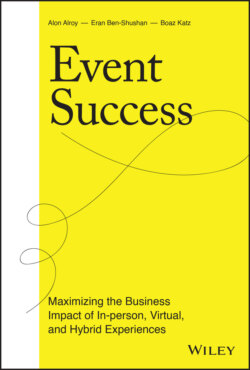Читать книгу Event Success - Alon Alroy - Страница 20
Digital by Default
ОглавлениеAs Orson and Colleen discovered early on in the pandemic, and as we did ourselves, virtual events dramatically increase a brand's reach. The initial excitement over registration and attendee numbers, however, was a vestige of the industry's past; event teams have long been accustomed to measuring success in terms of registrations and attendees. As the pandemic progressed and organizers got more sophisticated in their virtual event strategies, they discovered an ability to gather even more telling metrics, and began reconsidering how to benchmark an event's success.
Having a bigger audience is nice, but what really matters is how you engage with that audience—and by extension, how your audience engages with you. That's where data comes in. As events shift to a hybrid platform (where both in-person and virtual experiences are on the table) it becomes easier to track the attendee journey and cater experiences specifically to their needs.
This new approach to event success, ironically, has made it difficult for organizers to see themselves reverting back to an entirely in-person strategy in the future. The data that's generated from hybrid event platforms is so powerful, and the extended reach of virtual events so appealing, that the online format has quickly gone from a last resort to the first.
“What we wanted to do was take advantage of this blank slate that we had and say, ‘When events come back, we really need to think differently about the way that they come back,’ because we knew that the landscape would be permanently disrupted,” explained Nicola Kastner, the vice president and global head of event strategy at SAP. “What we did was take a data-driven approach to formulating our overall event strategy.”
Nicola tells us that in considering the future of events, she and her team studied four specific areas: attendee needs, SAP's marketing strategy, how to define event success, and how other industries had reacted to similar disruptions. Through that exercise, her team identified several findings that matched opportunities and trends raised by many event professionals across the industry, from how virtual attendee behaviors differ from in-person attendee behaviors to a trend toward smaller, local events over major international ones.
“All of these things have formulated our approach, so I believe we will take a much more localized, targeted approach to how we build our events in the future,” she says.
Nicola isn't the only one rethinking the effectiveness of the massive, in-person, flagship event that has long been the centerpiece of many organizations' event strategy.
“We will go back to live events, but we will go back only if and when it makes sense, both from our point of view and our clients' point of view,” says Orson of FT Live's new event strategy. “We don't want to lose hold of those new engaged global audiences, and the only way to do that is to maintain a digital-first approach to our events, even when we go back to physical [events].”
“We're going to be digital first, and physical with purpose,” adds Colleen, describing IBM's new event strategy. “This is a chance for us to reinvent how we think about face-to-face interactions, and where we show up, and how we show up. I think it would be a missed opportunity if any of us jumped back to the old ways of thinking.”
